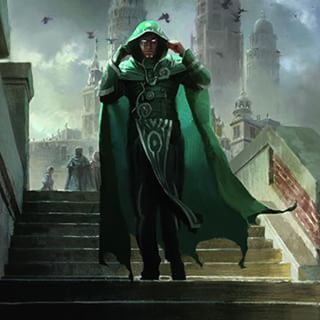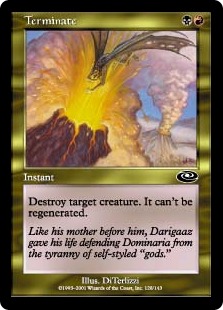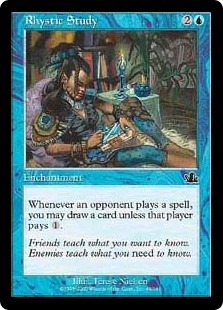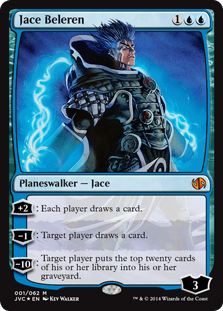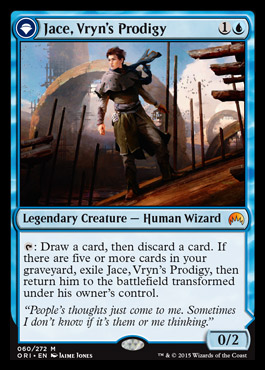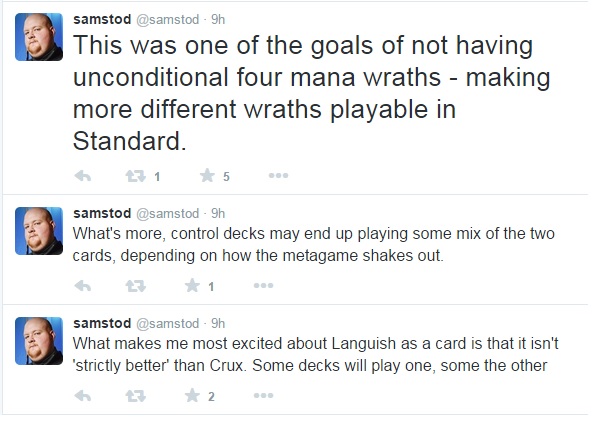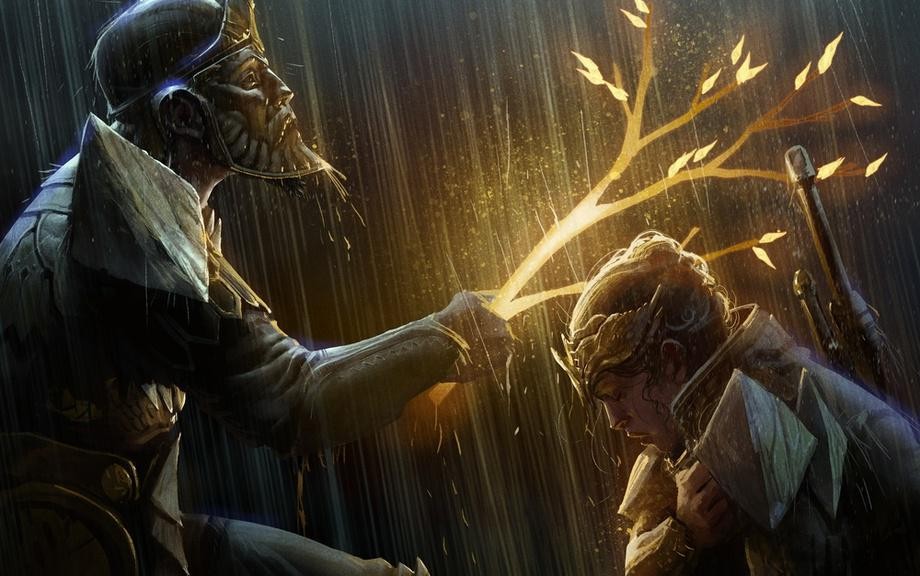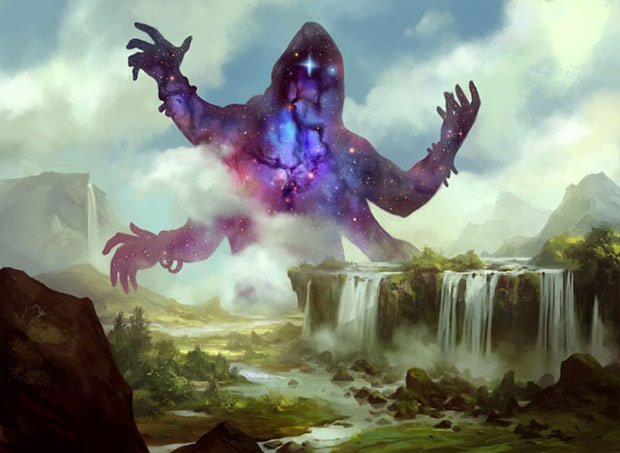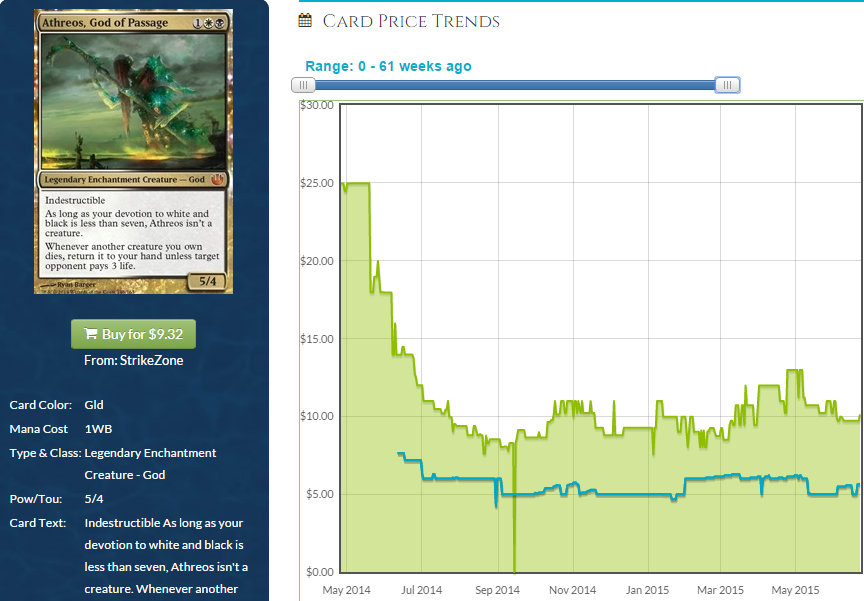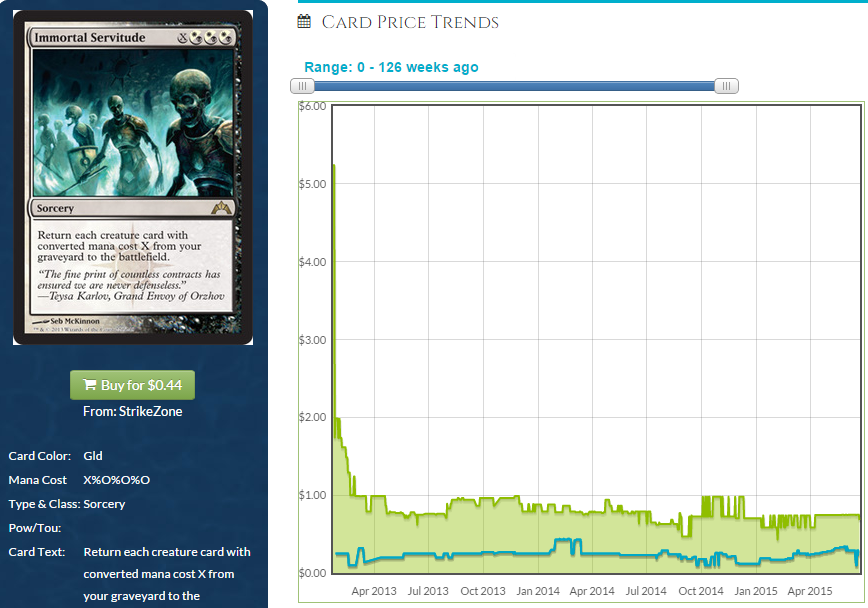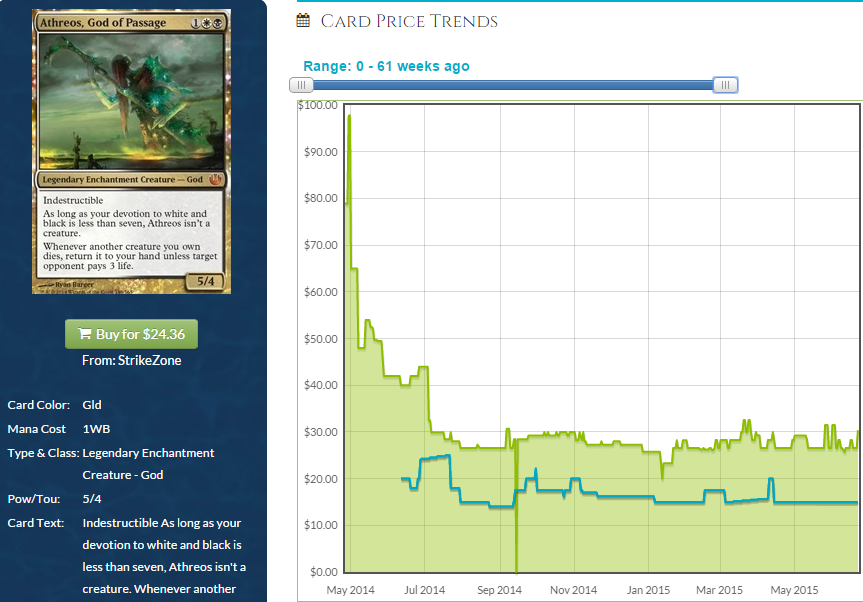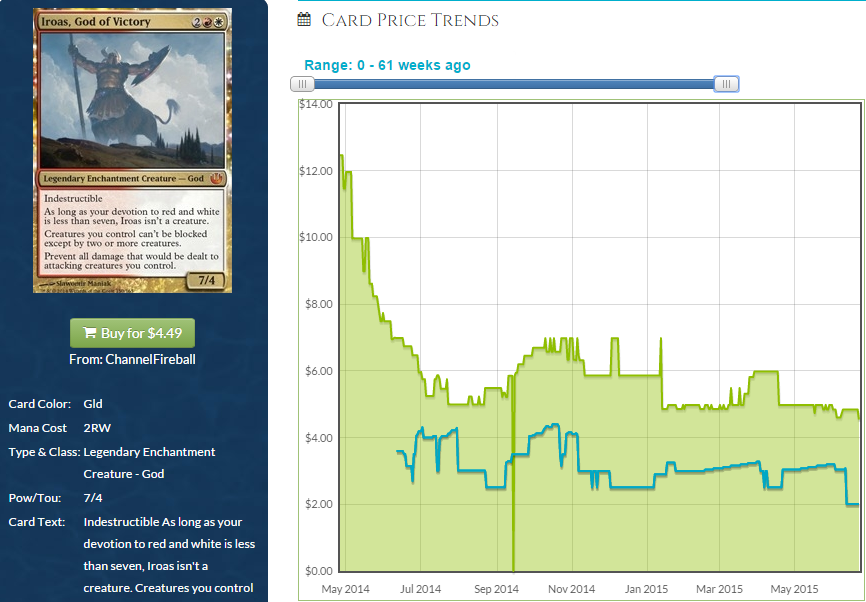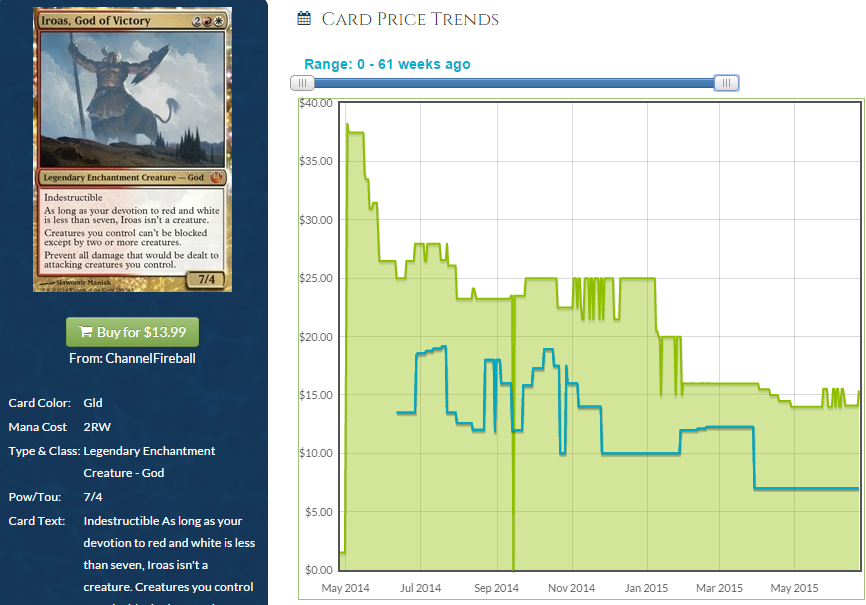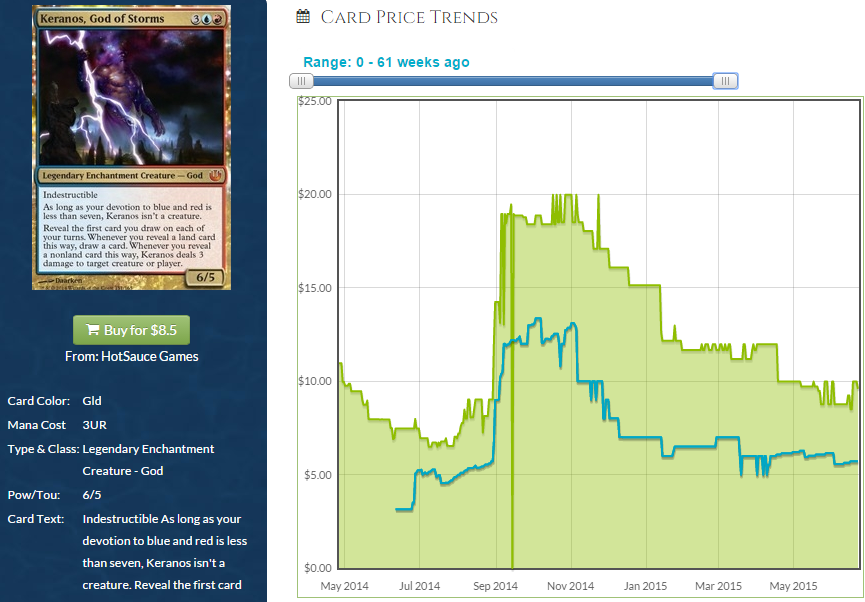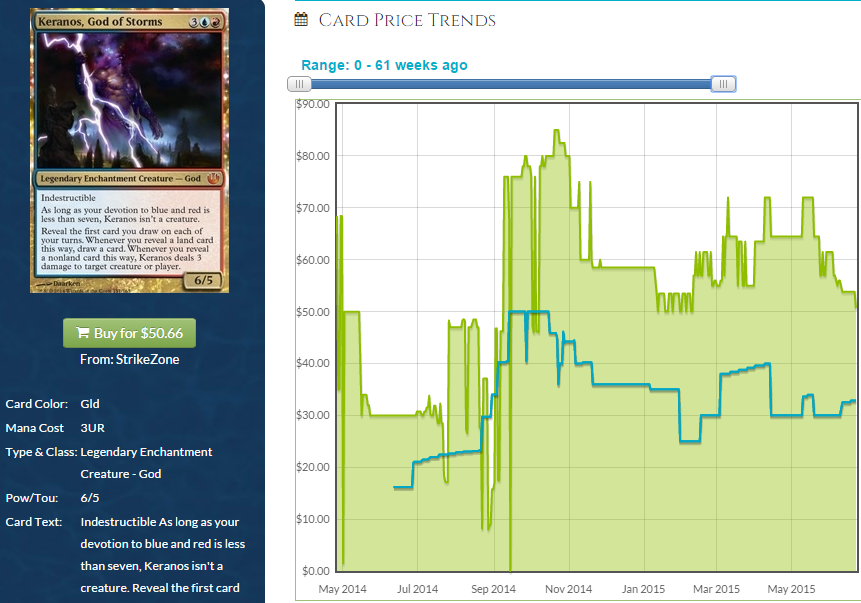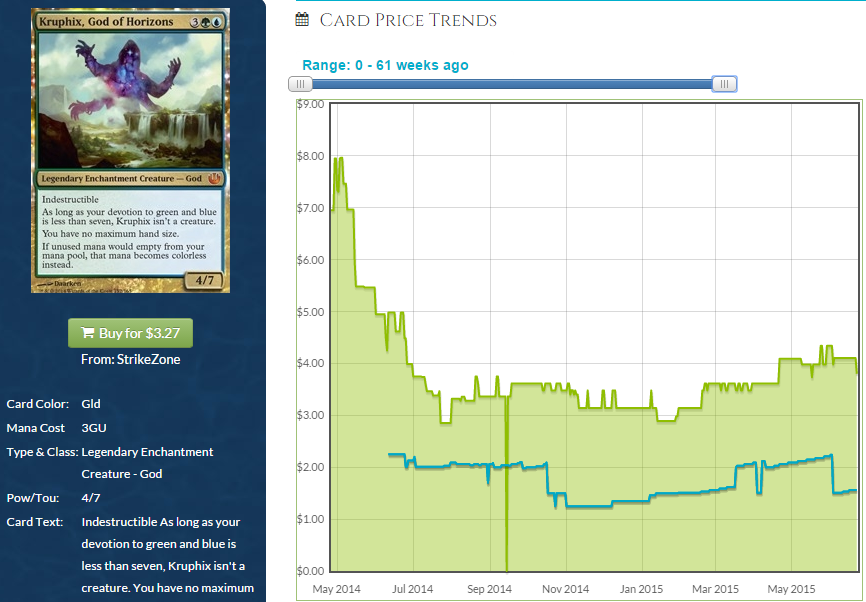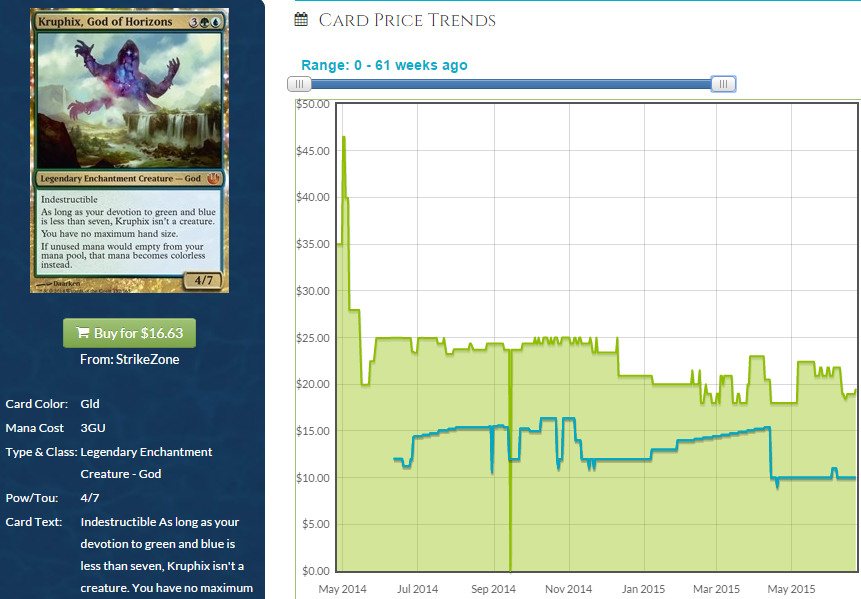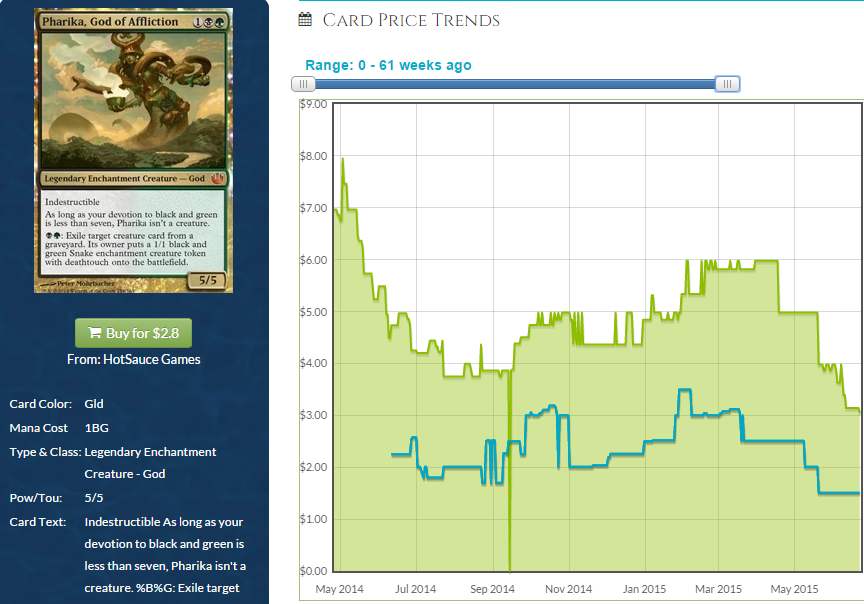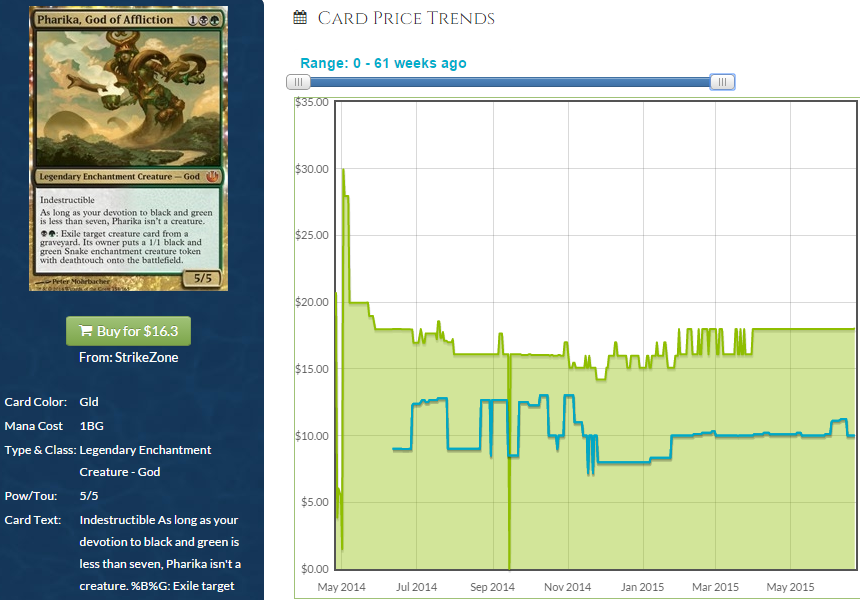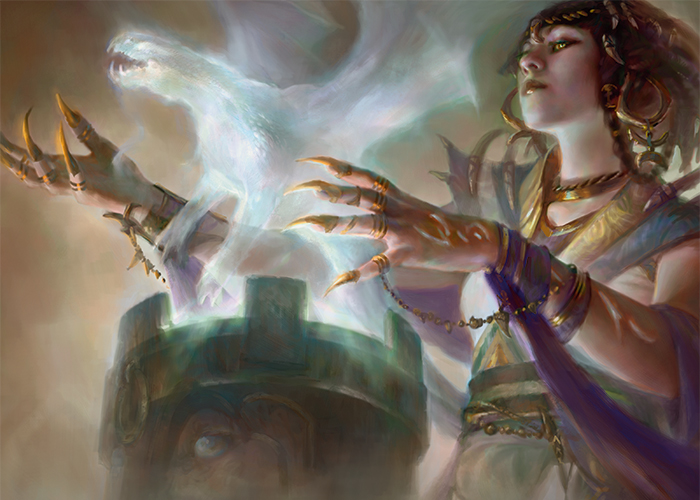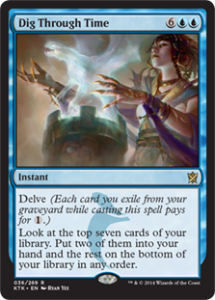We are going to jump around a little bit this week, but not too much. There is a lot of ground I want to cover, so let’s dive in.
The Tragedy of the Commons/Uncommons
Don’t worry, this section of the article is not going to focus on feudalism or agrarian economics in any way, I just really loved the title. I want to hit first and foremost on something that seems pretty weird, and that is the spiking of commons and uncommons in Modern.
When a rare or mythic spikes, it isn’t terribly surprising, since they are usually either out of older, underprinted sets (Blood Moon) or are multi-format staples that have just left print (Abrupt Decay). When demand exceeds supply, the cost has to go up to compensate.
You can even understand it in certain situations with uncommons—Kitchen Finks was north of $10 once, and it looks like it will be again soon. Kitchen Finks only exists in Modern Masters (underprinted compared to demand), Shadowmoor (underprinted versus current small set printings), and FNM promos (given out before at least a few of you were even playing Magic).
Terminate, though? Terminate is a common in Planeshift and Alara Reborn (both small sets prior to the Zendikar Boom), has had two promotional printings (Magic Player Rewards and FNM), and has been featured in three different supplemental printings (one of the original Commander decks, one of the Archenemy decks, and the Sorin vs Tibalt Duel Deck). I can understand the promos increasing, especially the MPR version—those have been very popular in the last year or so, and I am almost entirely out of mine (even the bad cards!). The supplemental copies make some sense too, since the first Commander run was kind of small, and I don’t know anybody who purchased Archenemy or Sorin vs Tibalt.
All that being said, I’ve found about ten copies of Alara Reborn Terminates lying around my house since I started typing this sentence. Am I just rich, or is this price unrealistic?
The problem with commons is that their base price is essentially free. The price you typically pay for commons in a store is the fee that is involved with actually going through the inventory to find it for you. Commons also have a much lower ceiling than any other rarity due to as-fan: I may only get one mythic in eight packs, but I’ll get eighty different commons. Khans and Dragons of Tarkir each had 101 commons, while Fate Reforged had 70. if I opened eight packs, it’s possible that I’ve gotten the vast majority of KTK/DTK commons, and every single FRF common (with repeats!). By contrast, Planeshift, featuring the first (and superior) version of Terminate, only had 55 commons in the set. Alara Reborn had 60.
Playability can drive the price of a common, but in general, the rarity is limited in power level due to its prevalence. A draft will feature 240 commons, and by making commons too powerful, you warp Limited.
So what do you do when a common card spikes? Well, the first thing you do is make sure that you have a neat and organized system for finding cards (or you swear to change your ways during the next available long weekend).
The next thing is you look for the best buylist price. Since Terminate has “spiked,” I have not been able to move any at the new price (be it through sales or PucaTrade). I was able to move one foil Alara Reborn copy, but it was on PucaTrade and at a discount. Currently, the best buylist price on the non-foil Alara Reborn Terminates is $1.78 from Strike Zone, which feels like an absolute steal. If you find you have a stack, then out them to a guaranteed source and let it absorb the risk.
If you have a regular game store that you shop or play at, I’d let them know of any that you come across, but I wouldn’t buy them for pennies with hope of a quick flip—you aren’t going to make very much, but there is potential to damage your relationship with the owner/operators. Typically, stores that don’t have all of their inventory electronically categorized can be places to find lots of unpicked longboxes, but you are likely to get more out of going through them as a helper than as a hunter. My LGS is staffed only by the owner, and he has more longboxes than he has time. I pull out things that I come across in his boxes when I’m bored and looking for something to occupy my ADD, but I get more in karma than I do in value.
I would be remiss if I didn’t mention some of the true corner case scenarios, like Serum Visions. In the case of certain cards, the avenues for a reprint are limited. Serum Visions, Daze, Brainstorm, and Preordain are the kinds of cards that can grow reprint equity at common (they are also all blue), but can’t be reprinted in a Standard expansion. Fortunately, WOTC is doing more supplemental products than ever before, so there are means to see more copies printed, but I think you have to be realistic about which ones offer the best possibilities. This is all speculation, but Wizards put reprints in products where they best fit (things like Flusterstorm aside). Serum Visions is a pretty lousy card in Commander, so I wouldn’t expect it in one of those types of products as opposed to Modern Masters 3 or a Modern Event Deck (are we still doing those?). I’d expect Rhystic Study to appear in a Commander set instead, even if it isn’t a better card for people wanting new copies of particular blue commons.
Moral of the story: Don’t bother chasing the vast majority of these spikes. There isn’t enough action to be hard, and the margins are probably too small. If you find that you have a pile of them, enjoy your trade-in credit.
Planeswalkers and Design Philosophy
My academic background, if I haven’t mentioned it before, is in history. One of the most important things you can learn with regards to history is that events are always influenced by their causes, and so you have to take the context of those causes into account whenever you are analyzing a given event. The new planeswalkers in Magic Origins, most specifically Jace, are being looked at the wrong way, and I think it is because WOTC is trying to change the way planeswalkers are used. I’m going to use the history of planeswalkers (both as a card type and as a, uh… fantasy… thing?) to make my point.
I’m not a very good Vorthos, but here is the history of planeswalkers in a nutshell. In the beginning, WOTC’s creative team made planeswalkers into basically indestructible, omnipotent gods who could make and destroy entire worlds at whim. This, surprisingly, is a terrible character type to try and build meaningful storytelling around. WOTC realized that planeswalkers were too powerful to be compelling (note that this is around the time that WOTC started looking into a potential movie deal), so the story was steered toward the Mending, where planeswalkers sacrificed much of their power to heal the fracturing of Dominaria or something.
The Mending, which occurred during Time Spiral block, meant that moving forward, planeswalkers wouldn’t make Emrakul, Aeons Torn look like a plant token and that they could be more realistically represented on cards! It is no coincidence that the first planeswalker cards appeared the following year (after being pushed out of Future Sight because of development concerns—the empty green card slot became Tarmogoyf!). The first five planeswalkers (known sometimes as the Lorwyn Five) were hugely resonant successes, and they all saw various amounts of constructed play (Chandra the least, Garruk and Jace the most).
For the first few years, however, planeswalker cards were somewhat lacking in terms of broader developmental context. A lot of the appeal was “shiny new things!” and without as much concern to whether they were good or not. I think for a little while WOTC was just glad they seemed to be working, but eventually R&D moved forward into new design space. Few colors had more than one planeswalker, so the good ones (think Elspeth, Knight-Errant) were played and the much less good ones (think Liliana Vess) mostly just weren’t. In a way, Jace, the Mind Sculptor represented what planeswalkers were like before the Mending: he went into every deck that played blue, and encouraged you to play blue if you weren’t already. JTMS wasn’t a nuanced, situational chess piece—he was a nuclear bomb. You either played Jace, or had to have a really compelling reason not to.
Designing planeswalkers is difficult for WOTC, since there are only a few printed during each given year. This low amount over time means that it takes longer for changes in design philosophy to manifest. Since Worldwake, there has been a push for planeswalkers to be more situational, rather than a pass/fail test of quality.
For example, is Ashiok good? Ashiok isn’t played as a four-of in the main deck of every list that could run it, but the card is also crucial in control mirrors. And the new Jace is very similar to Ashiok in that way. Jace, Vryn’s Prodigy comes down before most countermagic comes online in the control mirrors, and unlike Ashiok, it creates a difficult sideboarding decision for your control opponent: how much creature removal can they sideboard out and not be worse against an early Jace? Historically, looters have certainly been playable in control decks. Jace is a looter with high upside, including being a potential finisher for no additional mana investment. There are a lot of matches, however, where a 0/2 looter for two is going to be nothing more than eventual Shock fodder. The downside to being a situational star is that not all situations are favorable.
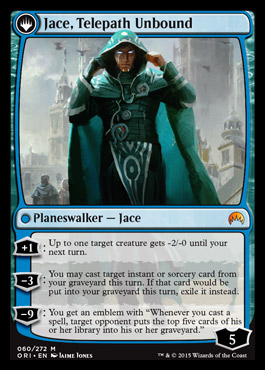
The finance lesson here is that planeswalkers are likely to be more specialized moving forward. This means that on the whole, they will be more consistently playable, although there will likely be much less crossover. Even though they are popular, WOTC doesn’t want a lot of Elspeth, Knight-Errants or Jace, the Mind Sculptors, because they narrow the range of the card type in general.
And just to take it a step further, this push isn’t unique to planeswalkers. Take a look at what Sam Stoddard had to say about Languish:
This really seems to be WOTC’s design and development philosophy moving forward, and I think it probably means a stronger, more active market for Standard. I’d much rather be trading and selling in a format with lots of “sometimes really good” cards than just a bunch of “good” or “not good” ones. If future formats can be as good as the one we have now, I think this means a lot of potential for the future. Make sure you have a diverse standard stock moving forward!
Moral of the story: planeswalkers, and Standard as a whole, are being developed in a way that is conducive to a wider format. I expect most of the future formats to be like Ravnica/Time Spiral in the sense that there are several good decks, but no overtly oppressive ones. These wider formats have more good cards, but fewer staples. If that’s the case, you can expect prices to be a little bit more even, as opposed to boom or bust. Tip: in these types of formats, the safest bets, as they always are, are the lands.
That’s all for today. I’d love to hear your thoughts on these topics, especially the second one. It was kind of a hard concept to put to paper, but I’d be more than happy to flesh it out in the comments. See you next week!
